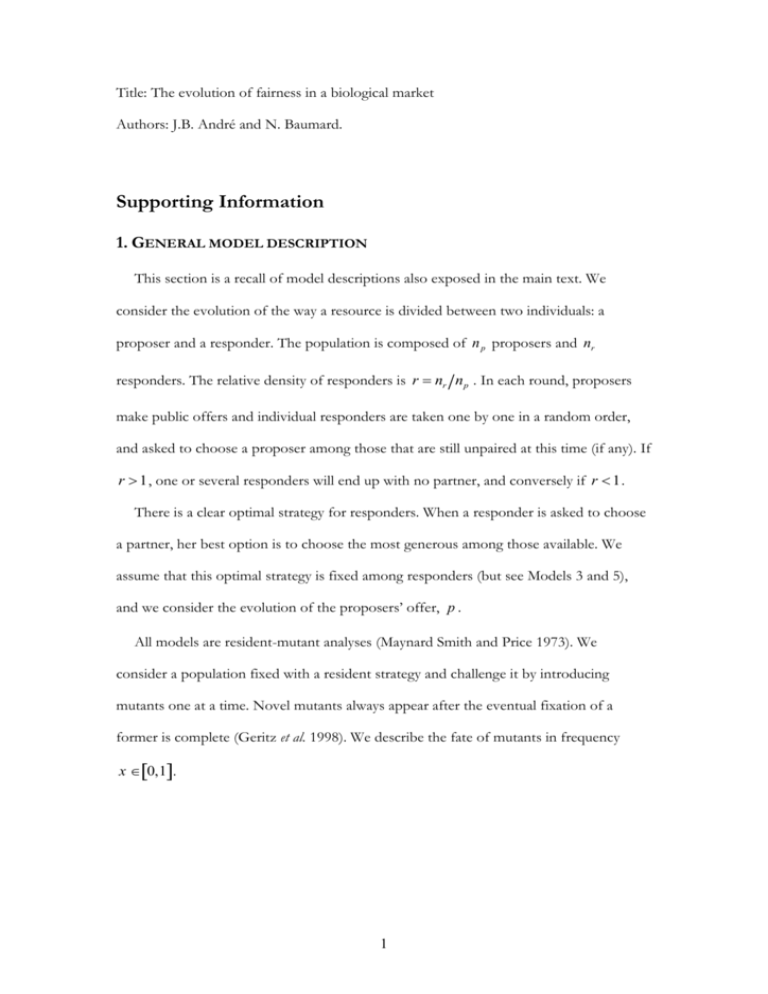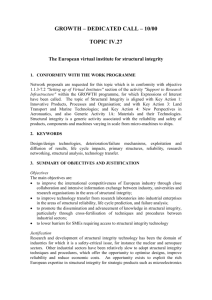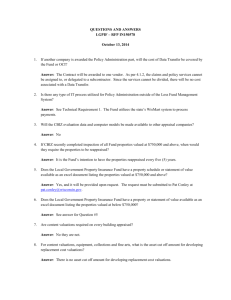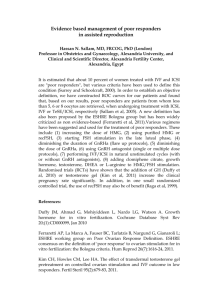Supporting Information
advertisement

Title: The evolution of fairness in a biological market Authors: J.B. André and N. Baumard. Supporting Information 1. GENERAL MODEL DESCRIPTION This section is a recall of model descriptions also exposed in the main text. We consider the evolution of the way a resource is divided between two individuals: a proposer and a responder. The population is composed of n p proposers and nr responders. The relative density of responders is r nr n p . In each round, proposers make public offers and individual responders are taken one by one in a random order, and asked to choose a proposer among those that are still unpaired at this time (if any). If r 1 , one or several responders will end up with no partner, and conversely if r 1 . There is a clear optimal strategy for responders. When a responder is asked to choose a partner, her best option is to choose the most generous among those available. We assume that this optimal strategy is fixed among responders (but see Models 3 and 5), and we consider the evolution of the proposers’ offer, p . All models are resident-mutant analyses (Maynard Smith and Price 1973). We consider a population fixed with a resident strategy and challenge it by introducing mutants one at a time. Novel mutants always appear after the eventual fixation of a former is complete (Geritz et al. 1998). We describe the fate of mutants in frequency x 0,1. 1 MODEL 2. A BIOLOGICAL MARKET WITH VARYING SUPPLY AND DEMAND We consider the same model as Model 1 (described in main text) with a single novelty: the respective density of proposers and responders are not fixed. They evolve as a function of the payoffs obtained in each role. Assume that the average payoff of proposers, denoted Pp , is strictly larger than the average payoff of responders, Pr , in a given round. The frequency of proposers is likely to increase in the next round (or in the next generation). The equilibrium frequency of each role is reached when both have the same average payoff. We call this the “ecological equilibrium” of the system (see main text). Consider a resident population of proposers offering p . The average payoffs of proposers and responders are 1 p and p r , respectively, if proposers are limiting ( r 1 ), and r 1 p and p , respectively, if responders are limiting ( r 1 ). The ecological equilibrium of role frequency is reached when the relative density of responders is r̂ p 1 p . The frequency of proposers at equilibrium is then 1 1 r̂ 1 p , and the frequency of responders r̂ 1 r̂ p . Our aim is to understand the evolution of p in this context (i.e. when it affects role frequency as above). We consider a situation in which role is a plastic trait, such that the dynamics of role frequency are much faster than the evolution of offers. 2.1. Mutants do not affect role frequency before they reach fixation A first, simplified, approach is aimed at understanding the basic principles at work. Consider a resident proposer population with offer p . Proposers are in frequency 1 p , and responders in frequency p (the ecological equilibrium). Consider a mutant proposer, 2 in frequency x , with offer p p . The mutant is assumed not to affect role frequency (whatever x and ). The analysis developed in section 1 above can thus be applied straightforwardly, by taking n p 1 p and nr p . (1) When resident proposers are generous or fair ( p 0, 5 ), responders are more frequent than proposers ( r̂ 1 ). Mutants are favoured and reach fixation if and only if they are less generous than residents (i.e. iff p p ). (2) When resident proposers are stingy ( p 0, 5 ), responders are strictly less frequent than proposers ( r̂ 1 ). More generous mutants are favoured and reach fixation if and only if their effect is sufficiently weak (i.e. iff p p 1 p ). More stingy mutants are favoured and reach fixation iff their initial frequency, x , and their effect, 0 , are both large enough (iff x 1 p 1 p and 2 p 1 p 1 p 1 x ). Overall, if mutants are rare and/or of weak effect, the fair strategy ( p 0, 5 ) is convergence stable (Eshel 1983; Geritz et al. 1998). However, when the fair strategy is fixed then stingy mutants can be favoured: the fair strategy is not evolutionarily stable. Yet, if stingy mutants have a weak effect, then the fixation of a stingy mutant does not move the population far away from fairness, and once the mutant is fixed then generous mutants rise, moving the population back toward fairness. Overall, the population always remains close to the fair strategy. The outcome is different, however, if mutants can have strong effects, and even more so if strong-effect mutants are also introduced in large frequency. Yet, before drawing conclusions, we must consider the fact that mutants do affect role frequency before they reach fixation. 2.2. Mutants affect role frequency before they reach fixation To get an intuitive understanding of the mechanism we are heading to, consider the case where a fair resident is fixed ( p 0, 5 ). Responders and proposers are in exactly 3 equal density (the ecological equilibrium). Any stingy mutant can increase in frequency. A strong-effect mutant might thus move the population far away from fairness (at least temporarily). And yet, far before reaching fixation, such mutants would also modify significantly the ecological equilibrium, depleting the frequency of responders by reducing their average payoff. This might impair the very success of the stingy mutants because, as soon as responders become limiting, they are the first to be left with no partner. The following analysis aims at capturing this phenomenon. We assume that one’s trading class (responder or proposer) is not genetic but epigenetic and can change very rapidly, as compared to the rate of change of gene frequency in the population. In result, for any composition of the proposer population, the ecological equilibrium of role frequency is immediately reached in the population, and the average payoff of responders always equates that of proposers. This assumption is relaxed in simulations. Denote r̂ p, p, x the relative density of responders ( nr n p ) at ecological equilibrium when the proposer population is composed of a resident, offering p , in frequency 1 x , and a mutant, offering p , in frequency x . For simplicity we often write r̂ r̂ p, p, x . If the average payoffs of proposers and responders are Pp and Pr , respectively, r̂ p, p, x must satisfy Pp Pr . Preliminary result: If the population is composed of a mixture of proposers offering p1 and proposers offering p2 , the relative density of responders at ecological equilibrium lies between r̂1 r̂ p1 , p2 , 0 p1 1 p1 and r̂2 r̂ p1 , p2 ,1 p2 1 p2 . This is proven by delineating three cases. Let us assume p1 p2 , and denote xi the frequency of proposers offering pi . Our aim is to prove that r̂ r̂2 , r̂1 . 4 Case 1: Assume that the parameters are such that r̂ x1 . The payoffs of proposers and responders are Pp r̂ 1 p1 and Pr p1 , respectively. The condition Pp Pr yields r̂ p1 1 p1 r̂2 , r̂1 . Case 2: Assume that the parameters are such that r̂ x1 ,1. The payoffs of proposers and responders are Pp r̂ 1 p2 x1 p1 p2 and Pr p2 x1 r̂ p1 p2 , respectively. The condition Pp Pr is a quadratic equation with a positive solution. Therefore, there exists an ecological equilibrium r̂ . If r̂ was strictly smaller than r2 , this would give Pp p2 and Pr p2 , and the payoffs of proposers and responders could not be equal. If r̂ was strictly larger than r̂1 , this would give Pp p1 and Pr p1 , and the two payoffs could not be equal either. Therefore r̂ must satisfy r̂ r̂2 , r̂1 . Case 3: Assume that the parameters are such that r̂ 1 . The payoffs of proposers and responders are Pp x1 1 p1 x2 1 p2 and Pr x1 p1 x2 p2 r̂ , respectively. The condition Pp Pr yields r̂ x1 p1 x2 p2 x1 1 p1 x2 1 p2 . With p1 p2 , this implies r̂ r̂2 , r̂1 . In conclusion, in all three cases, the relative density of responders at ecological equilibrium is r̂ r̂2 , r̂1 . In what follows, we consider each possible resident offer p , and assess its evolutionary stability by challenging it with every possible mutant offering p , introduced in frequency x . 2.2.1. Residents are generous or fair; mutants are even more generous Here p 0, 5 and p p . Proposers are limiting whatever mutant frequency (see preliminary result). Residents’ and mutants’ payoffs are P 1 p and P 1 p P , respectively. Mutants decrease in frequency until complete extinction. 5 2.2.2. Residents are generous; mutants are less generous but at least fair Here p 0, 5 and p 0,5, p . Proposers are limiting whatever mutant frequency (see preliminary result). Residents’ and mutants’ payoffs are P 1 p and P 1 p P , respectively. Mutants increase in frequency until complete fixation. 2.2.3. Residents are stingy or fair; mutants are even stingier Here p 0, 5 and p p . Responders remain limiting whatever mutant frequency (see preliminary result). We delineate two sub-cases. - If x 1 r̂ , mutants find no partner, residents’ and mutants’ payoffs are P 1 p r̂ 1 x and P 0 , respectively. Mutants’ payoff is strictly lower. - If x 1 r̂ residents’ and mutants’ payoffs are P 1 p and P r̂ 1 x 1 p x , respectively. Our aim is to compute the sign of P P P . After some simple algebra, the ecological equilibrium condition ( Pr Pp ) yields xP 2 p 1 r̂ r̂ 1 x , which is strictly negative (recall that r̂ 1 , p 0, 5 , and 0 ). In conclusion, whatever their frequency, mutants are counter-selected. They decrease in frequency until complete extinction. 2.2.4. Residents are stingy; mutants are more generous but at most fair Here p 0, 5 and p p,0,5 . Responders remain limiting whatever mutant frequency (see preliminary result). We delineate two sub-cases. 6 - If x r̂ , mutants always find a partner, residents’ and mutants’ payoffs are P r̂ x 1 p 1 x and P 1 p , respectively. Our aim is to compute the sign of P P P . After some algebra, the ecological equilibrium condition ( Pr Pp ) yields 1 x P 1 2 p 1 r̂x . With r̂ p 1 p (see preliminary result), this yields 1 x P 1 2 p p p 1 px . If is sufficiently small (precisely if p 1 2 p ), then P 0 and mutants increase in frequency. - If x r̂ , only mutants find a partner. Residents’ and mutants’ payoffs are P 0 , and P r̂ x 1 p , respectively. Mutants increase in frequency. In conclusion, whatever their frequency, mutants are favoured. They increase in frequency until complete fixation. 2.2.5. Stable coexistence of stingy and generous proposers Under some conditions, a generous ( p1 0.5 ) and a stingy proposer ( p2 0, 5 ) can stably coexist. This never occurs if mutations are of small effect, because it requires the appearance of a mutant very different from the resident (a stingy mutant appearing in a generous resident population, or vice versa). Yet, it may occur if mutations are of strong effect. In what follows we show that this possible coexistence does not undermine the evolution of fairness, because any mixture of generous and stingy proposers is itself susceptible to invasion by a fair mutant. Consider a resident population containing a mixture of various types of generous proposers in total frequency xg 1 and of stingy proposers in total frequency 1 xg , together with fair proposers in frequency x . The average offer effectively made in the population is called p e . The relative density of responders at ecological equilibrium is 7 always equal to r̂ pe 1 pe . We perform a demonstration in three steps. For simplicity, we assume that the frequency of each type of proposers varies continuously with time. (1) Depending on the initial mixture of offers, the initial population may either be in a state with r̂ 1 or with r̂ 1 . Here we show that the state r̂ 1 is unstable whereas the opposite state r̂ 1 is absorbing. Assume that the initial mixture is such that r̂ 1 . Every proposer finds a partner. The more stingy proposers always obtain a larger payoff than the more generous ones. In result, the average offer effectively made in the population, p e , and the relative density of responders, r̂ , both decrease continuously. This goes on at least until r̂ drops strictly below 1 , and p e thus strictly below 0, 5 . Therefore, r̂ 1 is not a stable state. Under the assumption that the population mixture changes continuously with time, this also implies that the opposite state ( r̂ 1 ) is absorbing. (2) Here we show that the relative density of responders at ecological equilibrium cannot be lower than x xg . Assume r̂ x xg . On the one hand, every responder would find a generous or fair partner and obtain an average payoff Pr 0, 5 . On the other hand, proposers would obtain in average Pp 0, 5 , because only generous or fair proposers would find a partner. This could not be an ecological equilibrium as Pr Pp . (3) Results (1) and (2) above imply that, whatever the initial composition of the population, at some point it reaches and remains in a state with r̂ x xg ,1 . Here, we show that in this state the fair strategy always increases in frequency. On the one hand, when r̂ 1 the average offer made is pe 0, 5 . Therefore, the average payoff of proposers (and responders) is itself pe 0, 5 . On the other hand, when r̂ x xg every fair proposer finds a partner and thus accrues a payoff exactly equal to 0, 5 . Whatever 8 their frequency, fair proposers thus obtain a larger payoff than the average proposers. Therefore, they increase in frequency and reach complete fixation. 2.2.6. Conclusion. We have demonstrated that (i) in a population of stingy proposers ( p 0, 5 ) some more generous proposers can invade whereas less generous ones cannot, (ii) in a population of generous proposers ( p 0, 5 ) some less generous proposers can invade whereas more generous ones cannot, (iii) in a population of fair proposers no mutant can increase in frequency, and finally (iv) even though stable mixtures of generous and stingy proposers can occur, fair proposers ( p 0, 5 ) can always invade them. In sum, fairness does evolve and is evolutionarily stable in all cases, whatever the frequency and the effects of mutants. As compared to the more ambivalent outcome of the case where the densities of proposers and responders are fixed (section 1), the above results are due to the fact that, when the density of proposers and responders immediately respond to the occurrence of a mutant, stingy mutants immediately pay the cost of their stinginess and are unable to rise in frequency in a fair population. This simple outcome is thus related to the assumption that the dynamics of role frequency is fast relative to the rate of evolution. Results would be different if the densities of proposers and responders were not responding as rapidly to the presence of stingy mutants. Stingy mutants could then benefit from their stinginess, and significantly increase in frequency, before they lead to a depletion of the frequency of responders. In order to observe this effect, and hence evaluate the limits of our assumptions, we performed stochastic simulations under the assumption that one’s role is genetically determined, and thus evolves owing to natural selection, at the same rate than offers. Simulations confirm the analytical results (Fig. SI1). The evolution of fairness is robust when mutants are either very rare and/or of very 9 weak effect. This occurs because (i) when stingy mutants are of weak effect they never move the population significantly far away from fairness, and (ii) when stingy mutants are very rare they never exceed the minimal frequency required to invade. When mutants are both frequent and of strong effect, the average offer is slightly lower than p 0, 5 at evolutionary equilibrium, owing to the presence of some stingy mutants (blue curve, in Fig. SI-1). MODEL 3. IMPERFECT RESPONDERS In Models 1 and 2, we have assumed that responders are able to choose perfectly among proposers. Consider for instance the situation where responders are limiting ( r 1 ). If every resident proposer offers p , except a single mutant offering p , then resident proposers have an intermediate probability of finding a partner (approximately equal to r ), whereas the mutant is certain to find a partner (because he will be the first chosen by responders). This remains true even if is infinitely small. Therefore, the probability of finding a partner increases with an infinite slope with one’s offer. This is not realistic. In reality, responders are not able to discriminate so efficiently among proposers (see main text). As a result, when a mutant offers only a little bit more than a resident, it should be a little bit more likely to find a partner, but not certain to do so. Here, we want to verify that our results hold under this more realistic assumption. In order to capture the imperfection of responders’ choices in a simple model, we build a quantitative model of choice. For simplicity, in this model, we consider weak selection, i.e. we consider a population where all offers are very close to the average. In a resident population with average offer p , we assume that the probability for a given proposer to find a partner is a continuous function of the difference between his 10 own offer, p , and the average p , and this probability is denoted r , where p p . This probability also depends on the relative density of responders ( r nr n p ). If responders are limiting ( r 1 ), the probability of finding a partner when one offers the average offer is r 0 r , and r is monotonically growing with . If proposers are limiting ( r 1 ), then every proposer is certain to end up with a partner, and r is constant ( , r 1 ). Consider a population with average offer p . The payoff of individuals offering pi writes P pi , p r pi p 1 pi . Assuming weak selection (every offer is close to the average), the change of the average offer from one generation to the next is proportional to the first order effect of pi on payoff, given by P pi , p pi . pi p 3.1. Fixed supply and demand Let us first consider the case where the respective densities of proposers and responders are fixed parameters of the model. It yields two results: - When proposers are limiting ( r 1 ), the first order effect of pi on payoff is 1 . The average offer decreases owing to selection. - When responders are strictly limiting ( r 1 ), the first order effect of pi on payoff is 1 p r 0 r (recall that r 0 r ). The average offer increases owing to selection if and only if responders’ sensitivity is sufficient ( r 0 r 1 p ). However, once the average offer becomes too large, proposers gain very little when they find a partner ( 1 p is small). In result, the strength of selection upon them to improve their probability of finding a partner becomes quite small, and selection is unable to lead to a further 11 increase of offers. Therefore, in contrast with the “perfect choice” models, evolution does not lead to the maximal possible offer in this case. 3.2. Varying supply and demand Let us now consider the case where the densities of proposers and responders vary in function of their payoff. We consider a population with average offer p . Thanks to the weak selection hypothesis, we restrict our analysis to the cases in which proposers are either all stingy or all generous, and we neglect cases in which the population is composed of a mixture of generous and stingy proposers. The equilibrium value of the ratio r nr n p is given by r̂ pe 1 pe , where p e is the average offer effectively played in the population, which is at most equal to the most generous offer present in the population (i.e. pe max pi ). i - When the average offer is generous ( p 0, 5 ), it can be shown that proposers are necessarily strictly limiting ( r̂ 1 ), every proposer ends up with a partner, the first order effect of pi on payoff is 1 . The average offer decreases owing to selection. - When the average offer is stingy ( p 0, 5 ), it can be shown that responders are necessarily strictly limiting ( r̂ 1 ), the first order effect of pi on payoff is strictly positive iff r̂ 0 r̂ 1 p . The average offer increases owing to selection for every p 0, 5 and every r̂ 1 if 0,5 0 2 . - When the fair offer is fixed ( p 0, 5 ), proposers and responders are in equal density ( r̂ 1 ), and stingy mutants can increase in frequency. However, this immediately reduces the average offer strictly below 0, 5 , and selection then pushes back the average offer toward fairness. 12 In conclusion, fairness evolves even when responders do not have perfect information and perfect discriminating abilities, as long as the probability for a proposer to find a partner is an increasing function of the proposer’s offer with a sufficient slope (larger than 2 in our model). MODEL 4. FAIRNESS IN ASYMMETRIC INTERACTIONS In many real life cases, partners in an interaction differ in terms of their payoffs. The evolutionarily stable resource division might then not be symmetric. In order to deal with this more general case, we developed a further model. For simplicity, we consider weak selection, i.e. we consider a resident offering p and a mutant offering p p . Consider an interaction between a proposer and a responder, in which the responder gets a fraction p of the resource. The proposer accrues a payoff Pp bp 1 p c p , and the responder Pr br p cr , where bi is the marginal benefit of each resource unit and ci the cost of the social interaction, for individuals of type i . Because the interaction now has a cost, we need to consider the possibility for individuals to refuse social interactions if their benefit is lower than their cost. Proposers will never evolve an offer p such that bp 1 p c p . Therefore, the maximal offer to be considered in this model is pmax b p c p b p . Conversely, responders will always reject any offer p such that br p cr . Therefore, the minimal offer to be considered is pmin cr br . 4.1. Fixed supply and demand Let us first consider the case where the respective densities of proposers and responders are fixed parameters of the model. It yields two results: 13 - When proposers are limiting, their payoff is a linearly decreasing function of their offer. Evolution leads to a reduction of offers down to pmin cr br . - When responders are limiting, more generous mutants with bp 1 p c p 1 r 1 x are favoured, and reach complete fixation. Evolution leads to the maximal possible offer ( pmax b p c p b p ). 4.2. Varying supply and demand When the respective density of proposers and responders vary in function of their payoff, we will show that evolution converges toward a so-called fair offer p* . Here as well, thanks to the weak selection hypothesis, we restrict our analysis to the cases in which the resident and the mutant are either both stingy ( p p* and p p* ) or both generous ( p p* and p p* ), and we neglect cases in which the population is composed of a mixture of generous and stingy proposers. - When the resident offer is such that responders’ payoff is strictly larger than proposers’ payoff ( Pr Pp ), proposers are strictly limiting ( r̂ 1 ), every proposer ends up with a partner, and less generous mutants are thus favoured, and rise to fixation. - When the resident offer is such that proposers’ payoff is strictly larger than responders’ payoff ( Pr Pp ), responders are strictly limiting ( r̂ 1 ), and less stingy mutants are thus favoured and rise to fixation. - When the fair offer is fixed ( Pr Pp ), proposers and responders are in equal density ( r̂ 1 ), and stingy mutants can increase in frequency. However, this immediately reduces the relative density of responders, and selection then pushes back the average offer toward fairness. 14 In summary, evolution converges toward the so-called fair resource division that equalizes Pp and Pr . This is the split p* bp cr c p b p br . This is valid iff pmin p* pmax , which implies that the benefit parameters ( bi ) are sufficiently large relative to the cost parameters ( ci ). MODEL 5. JOINT EVOLUTION OF PROPOSERS’ OFFER AND RESPONDERS’ REQUEST Consider a population with a density n p of proposers and nr of responders, and consider a pairing procedure with two stages (see main text). Proposers are characterized by their offer p , and responders by the minimal offer they are ready to accept in the first stage, q . In what follows, we use simple mathematical arguments to describe qualitatively (i) the evolution of responders’ request for a fixed proposers’ offer, and (ii) the evolution of proposers’ offer for a fixed responders’ request. Finally, we use verbal arguments to describe the joint evolution of both traits when the density of each trading class varies freely. 5.1. Evolution of responders’ request, q In order to measure the selective pressure on the responder’s side, we must introduce some background variability of offer. When a proposer is genetically characterized by an offer p , we assume that he in fact really makes an offer p̂ p , where is a random variable with expectation 0 . For simplicity we assume that trembles do not carry over from the first pairing stage to the second, i.e. the error made by a given proposer in the second pairing stage is independent from the error he possibly made in the first stage. 15 We assume that the respective densities of proposers and responders are fixed parameters. We consider a resident proposer population fixed with an offer p (plus some trembles), and a resident responder population fixed with a minimal request q . We aim to characterize the evolutionarily stable request. 5.1.1. Proposers are limiting ( r 1 ) When proposers are limiting in the first pairing stage, they are also limiting in the second stage. Therefore, responders will eventually have to accept every proposer in the second stage, and some responders will even remain unpaired. The expected payoff a responder can hope to accrue in the second pairing stage is hence strictly lower than the average offer p made by proposers. Therefore, the evolutionarily stable strategy is to accept, in the first stage, even offers that are at least a little bit lower than the average offer, i.e. the evolutionarily stable request is q* p . We do not need to characterize more precisely q* . 5.1.2. Responders are limiting ( r 1 ) When proposers are limiting in the first pairing stage, they are also limiting in the second stage. Therefore, every responder will eventually find a partner in the second pairing stage, and the least generous proposers will be left out. The expected payoff a responder can hope to accrue in the second pairing stage is hence strictly larger than the average offer p made by proposers. Therefore, the evolutionarily stable strategy is to accept, in the first stage, only offers that are at least a little bit larger than the average offer, i.e. the evolutionarily stable request is q* p . We do not need to characterize more precisely q* . 16 5.1.3. Proposers and responders are in equal density ( r 1 ) In this case, the expected payoff a responder can hope to accrue in the second pairing stage is exactly given by the average offer p . Therefore, the evolutionarily stable strategy is to accept, in the first stage, only offers that are at least equal to p , but not less, i.e. the evolutionarily stable request is q* p . 5.2. Evolution of proposers’ offer, p Let us now consider the evolution of proposers’ offers when responders are characterized by a given request. For simplicity, in this analysis we assume that the effect of trembles is small relative to the effect of actual mutations on offers. Therefore we neglect this background variability when we compare the payoff of resident and mutant proposers. 5.2.1. Proposers are limiting ( r 1 ) In this case, the fact that responders have a minimal request q does not affect the outcome (because every proposer eventually ends up with a partner). In line with Model 1, proposers’ payoff thus decreases monotonously with their offer, and evolution leads to the reduction of offers (possibly until the lowest possible offer is fixed). 5.2.2. Responders are limiting ( r 1 ) If proposers’ offer is initially strictly lower than responders’ request, all proposers move on to the second pairing stage. The analysis developed in Model 1 applies straightforwardly to this stage, and selection leads to an increase of proposers’ offer (because proposers compete to attract partners). This goes on until the offer is exactly p q . The inverse process occurs if proposers’ offer is initially strictly larger than 17 responders’ request. In both cases, natural selection tends to bring the offer closer and closer to the request. 5.2.3. Proposers and responders are in equal density ( r 1 ) If proposers’ offer is initially strictly lower than responders’ request, all proposers move on to the second pairing stage. The analysis developed in Model 1 applies straightforwardly to this stage, and selection leads to an increase of proposers’ offer (because proposers compete to attract partners). This goes on until the offer is exactly p q . The inverse process occurs if proposers’ offer is initially strictly larger than responders’ request. In both cases, natural selection tends to bring the offer closer and closer to the request. 5.3. Joint evolution of p , q , and r In a comprehensive process, proposers’ offer and responders’ request jointly evolve, and the respective densities of proposers and responders freely vary in function of payoffs. Here we describe verbally some qualitative properties of this dynamic process, based upon the above analyses. We use simulations to confirm our verbal predictions. Assume first that proposers’ offer is initially low ( p 0, 5 ), responders are strictly limiting because they are disadvantaged in the division ( r 1 ). Selection favours responders who request at least a little bit more than the average offer ( q* p , section 5.1.2). In turn, selection leads to an increase of proposers’ offer (section 5.2.2). This goes on until p 0, 5 and responders are no more limiting. The inverse process occurs when proposer’ offer is initially high ( p 0, 5 ). Proposers are strictly limiting because they are disadvantaged in the division ( r 1 ). Therefore, 18 selection leads to a reduction of proposers’ offer (section 5.2.1). This goes on until p 0, 5 and proposers are no more limiting. In both cases, evolution converges toward the fixation of fair proposers, and fair responders. Once this state is reached, however, stingy proposers can always increase in frequency (in line with SI section 2.1). Yet, if stingy mutants are of very weak effect their fixation does not move the population far away from fairness. And once stingy mutants are fixed, responders become limiting again, which selects for more demanding responders and more generous proposers, and moves the population back toward the fair state. The outcome is different if mutants can have strong effects, and even more so if strong-effect mutants are also produced in large numbers. However, in a more realistic process, very stingy proposers deplete the relative density of responders before they reach a high frequency (in line with SI section 2.2). We do not consider this mechanism analytically in the present model, but we show in simulations that the evolution of fairness on both sides is in fact relatively robust to mutation parameters (Fig. SI-2 and Fig. 2 of main text). 6. SIMULATIONS The simulation program in C is available upon request. The population size is fixed. Generations are non-overlapping. Individuals are haploids. They are genetically characterized by (i) their trading class (proposer or responder), (ii) their offer when they are a proposer and (iii) their minimal request when they are a responder. Mutations occur at the same rate at each locus. There is no recombination between loci. The life cycle is as follows: In each generation, (i) social interactions take place and individuals accrue a social payoff, (ii) a non social payoff is added, (iii) mutation and 19 recombination take place, (iv) the next generation is sampled as a multinomial distribution in which the expected number of adult offspring of each individual is equal to its payoff divided by the total payoff in the population. The social procedure (i) has two versions depending on whether we consider the evolution of responders’ choices or not. (1) First version: Responders are taken one by one and paired with the most generous proposer available; the resource share is then implemented. (2) Second version: Proposers and responders are first paired randomly and exchanges are implemented when possible (i.e. when the offer of the proposer is larger than the minimal request of the responder); still unpaired responders are secondarily taken one by one and paired with the most generous proposer available. In the model with responders’ choices, we introduce some forced variability in the offers. In each generation, every proposer has a certain probability of trembling. If he does, the tremble has a normally distributed effect with expectation 0 and standard deviation . The trembles are secondarily truncated so that the actual offers always lie between 0 and 1. REFERENCES Eshel, I. 1983. Evolutionary and continuous stability. Journal of Theoretical Biology 103:99-111. Geritz, S. A. H., E. Kisdi, G. Meszena, and J. A. J. Metz. 1998. Evolutionarily singular strategies and the adaptive growth and branching of the evolutionary tree. Evolutionary Ecology 12:35-57. Maynard Smith, J., and G. R. Price. 1973. The Logic of Animal Conflict. Nature 246:15-18. 20 21 22






